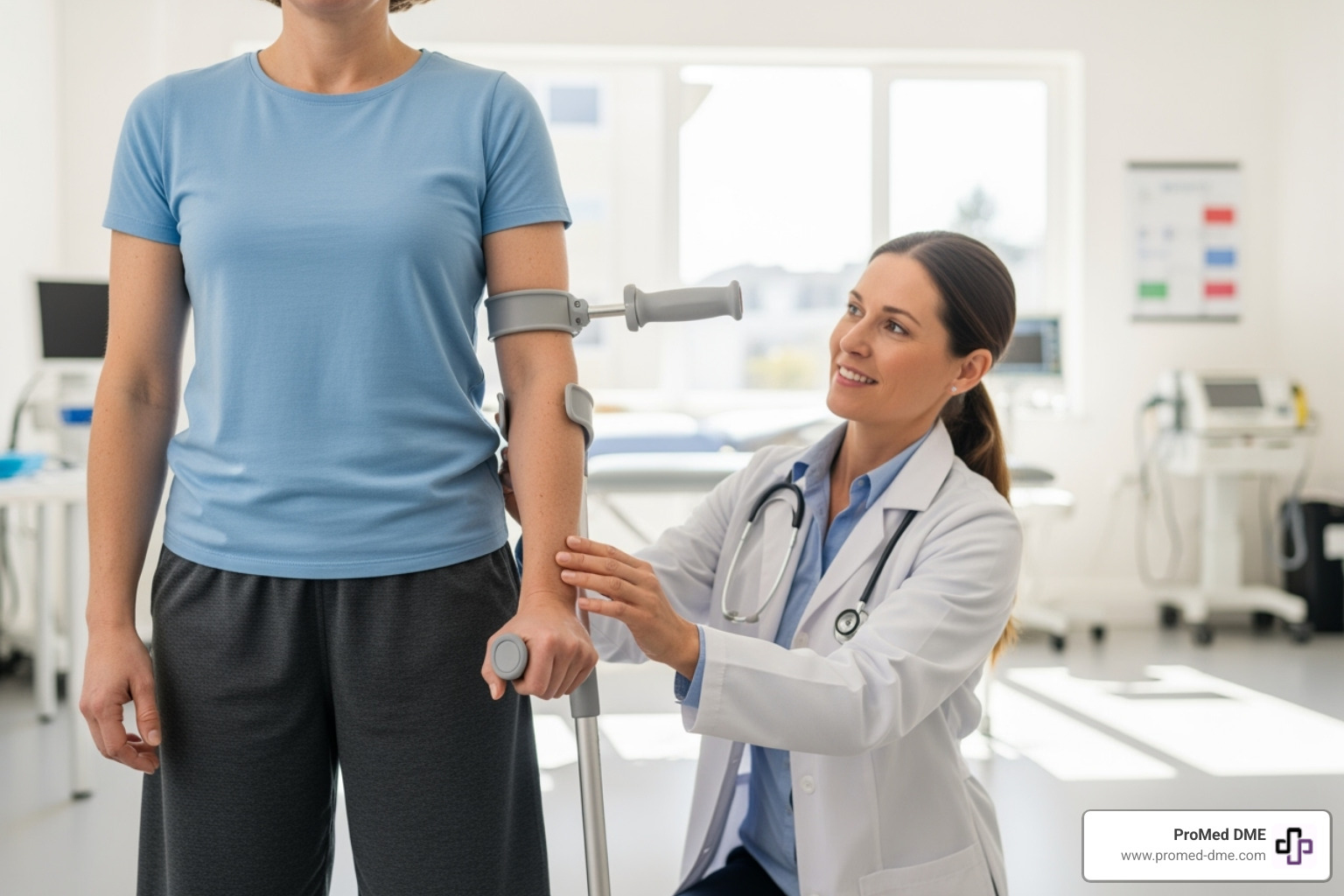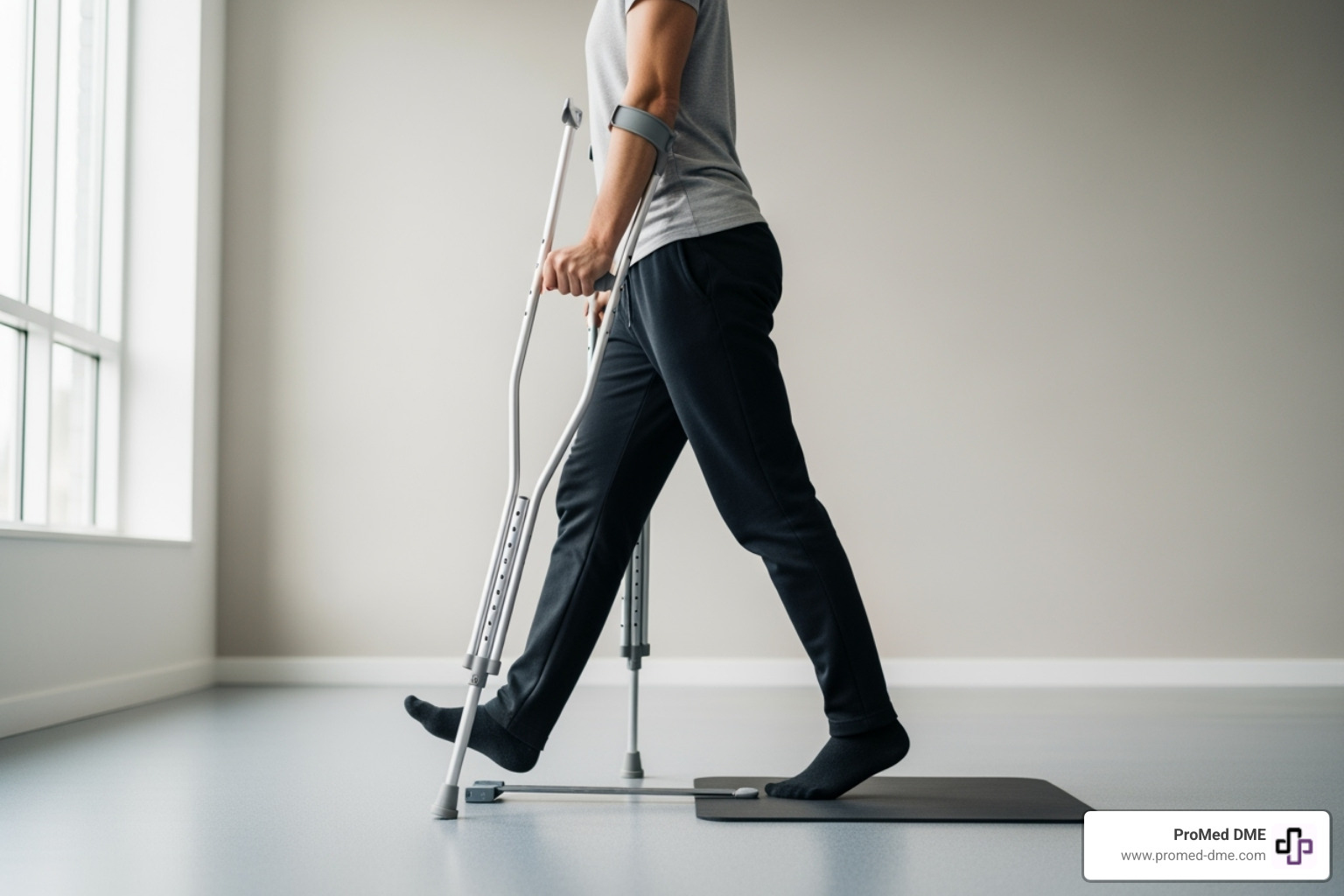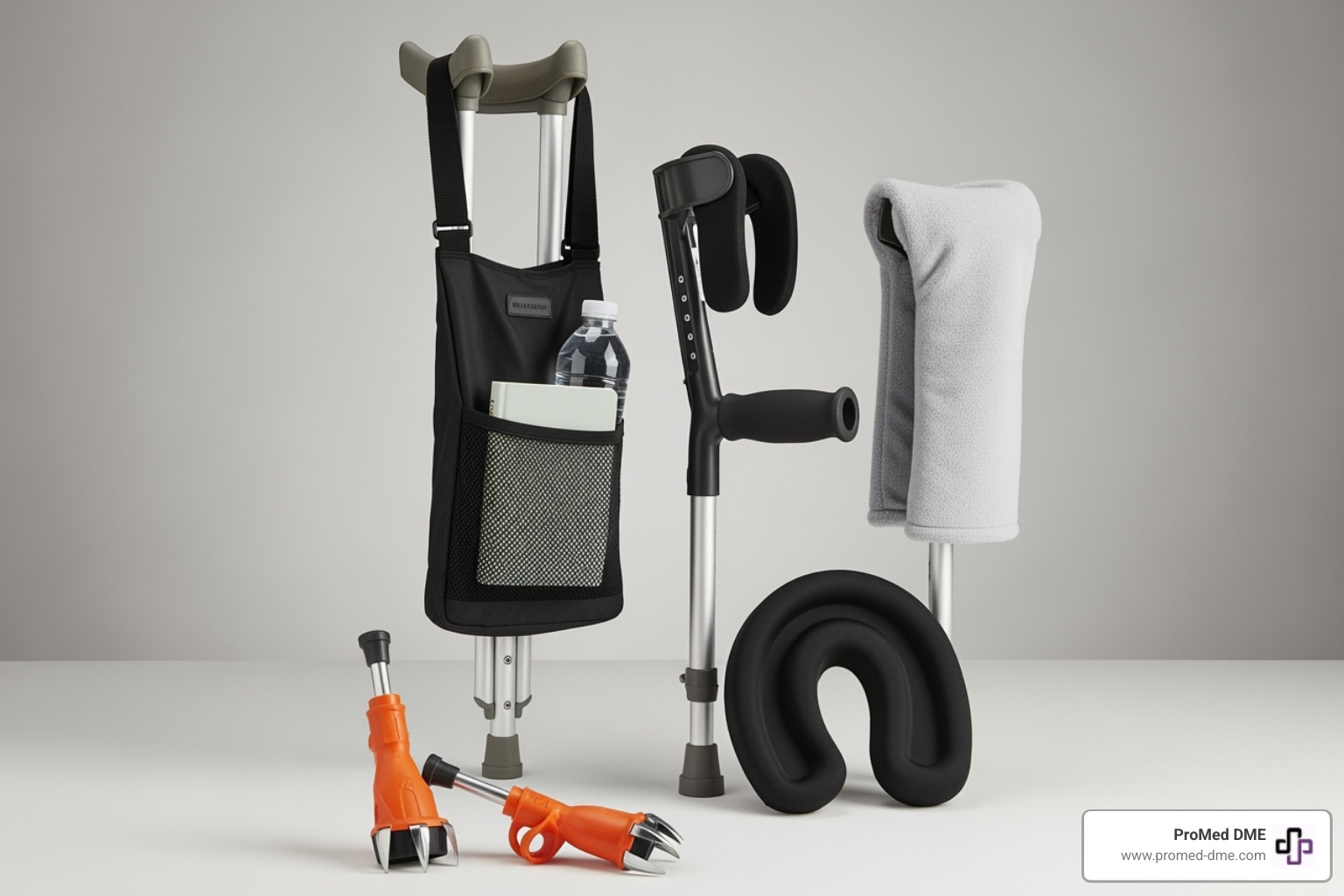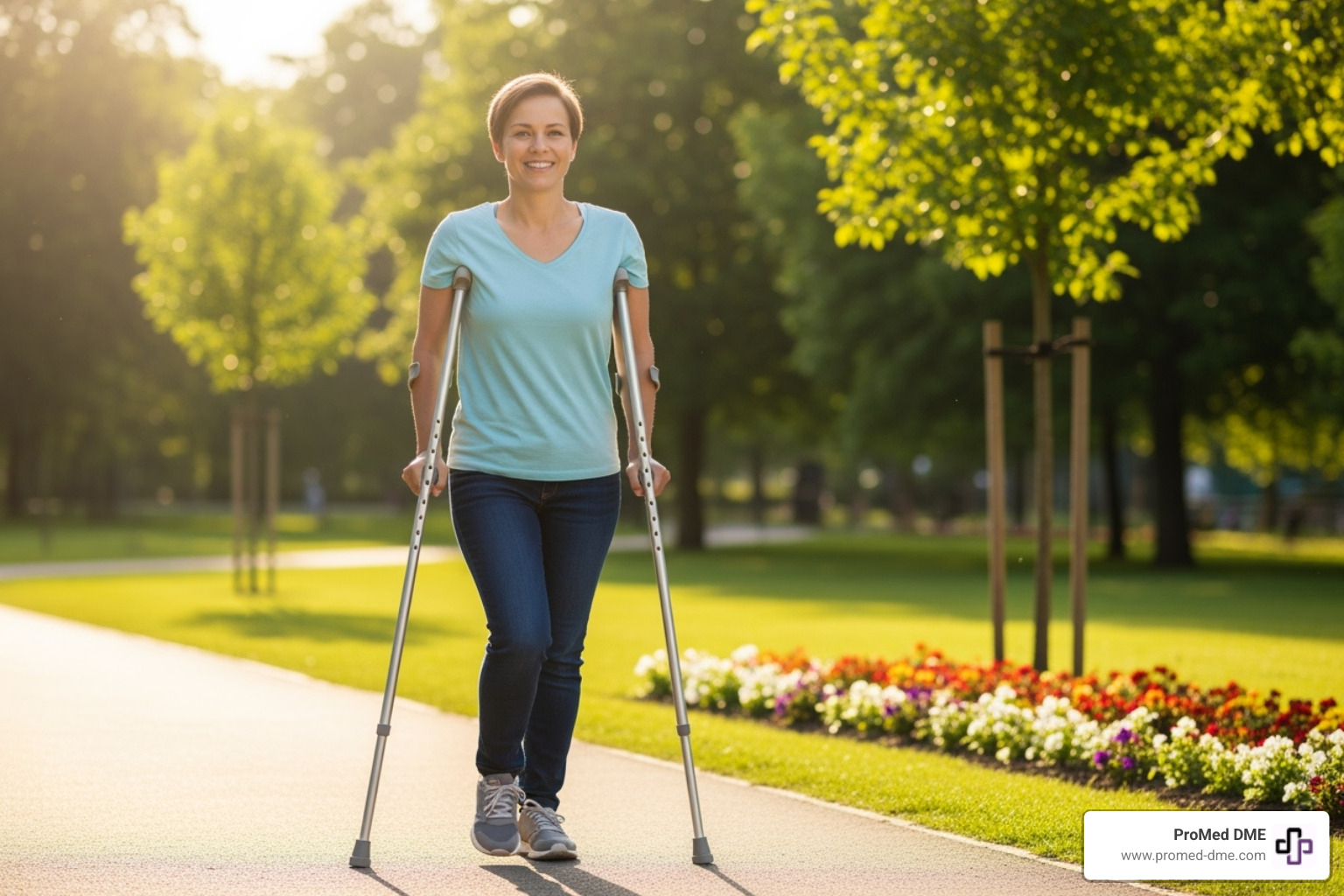5 Ways to Locate Crutches Like a Pro

Why Finding the Right Crutches Nearby Matters for Your Recovery
Finding crutches nearby doesn't have to be overwhelming. Whether you need them after surgery, an injury, or for long-term mobility support, getting the right crutches quickly can make all the difference in your recovery and independence.
Quick Guide to Finding Crutches Nearby:
- Medical supply stores - Best for professional fitting and insurance billing
- Local pharmacies - Convenient for basic underarm crutches (call ahead to check stock)
- Large retailers - Carry standard models for immediate purchase
- Online ordering - Widest selection with home delivery options
- Rental programs - Community loan closets for temporary needs
- Healthcare providers - Doctors and physical therapists for prescriptions and referrals
The key is knowing what type you need before you start shopping. Research shows that proper fitting is crucial—crutches should sit about 1-2 inches below your armpit with handgrips at wrist height when your arms are at your sides. Getting a pair of sturdy, quality crutches is an essential first step to getting back on your feet.
With prices ranging from under $20 for basic models to over $150 for hands-free knee crutches, understanding your options helps you make the best choice for both your needs and budget.

First, Know What You're Looking For: Types and Sizing
When an injury or surgery impacts your ability to walk, crutches nearby become your pathway back to independence. They transfer weight from your injured limb to your upper body, allowing you to move safely while you heal. However, not all crutches are the same, and choosing the right type is essential.
Before you start shopping, talk to your doctor or physical therapist. They can assess your injury, consider your lifestyle, and recommend the best crutches for you. This step can save you from discomfort and potential complications.
Proper fit isn't just about comfort—it's about safety. Ill-fitting crutches can cause nerve damage, skin irritation, and slow your recovery. Let's explore what you need to know.
Underarm vs. Forearm Crutches: What's the Difference?
When looking for crutches nearby, you'll mainly find two types: underarm (axillary) and forearm (Lofstrand). Each serves a different purpose.
Underarm crutches are the classic option, with padded tops that sit under your armpits and handgrips for support. They work well for short-term recovery from injuries like a sprained ankle or knee surgery.
A crucial tip: your weight should rest on your hands, not your armpits. Leaning on the armpit pads can damage nerves and blood vessels. The pads are for stability, not for bearing weight.
Forearm crutches have an open cuff that wraps around your forearm, plus a handgrip. They are often the preferred choice for long-term use because they are less tiring and allow more freedom of movement. The weight is distributed across your hands and forearms, which many find more comfortable. They are typically made of lightweight aluminum and can support up to 300 pounds.
| Feature | Underarm (Axillary) Crutches | Forearm (Lofstrand) Crutches |
|---|---|---|
| Typical Use | Short-term recovery (sprains, breaks, post-surgery) | Long-term support (chronic conditions, permanent needs) |
| User Strength Required | Good upper body and arm strength | Good upper body, forearm strength, and balance |
| Pros | High stability, easy to learn | More natural movement, less bulky, better for long-term use |
| Cons | Risk of nerve damage if misused, less agile | Requires better balance, learning curve for new users |
Other Specialty Crutches
Sometimes, standard crutches aren't enough. Platform crutches (or gutter crutches) are ideal for people who cannot bear weight through their hands or wrists due to conditions like severe arthritis. These crutches support the forearms with a platform and strap system.
Hands-free knee crutches are an innovative option for below-the-knee injuries. This device straps onto your injured leg, acting like a peg leg and freeing up your hands. They are perfect for foot fractures or ankle injuries but require good balance and core strength.
How to Get the Perfect Fit
Getting the right fit is critical. Poor fitting can lead to pain, nerve damage, and slower healing.
Start with armpit clearance. Stand straight with the crutches about six inches to the side of your feet. The top pad should be about 1-2 inches (two finger-widths) below your armpit.
Next, check your handgrip height. With your arms hanging naturally, the handgrips should align with your wrist or hip line. When you grab the grips, your elbows should have a slight bend (about 20-30 degrees). This position allows you to transfer weight correctly without straining your wrists or shoulders.
Most crutches are adjustable, so take the time to get the fit right. If possible, have a physical therapist or medical professional help you. A proper fit from the start will make your recovery journey much smoother.

For detailed guidance on proper technique and safety tips, check out the American College of Foot and Ankle Surgeons' Instructions for Using Crutches.
5 Places to Find Crutches Nearby and Online
Now that you understand the types of crutches and the importance of proper sizing, let's explore where to find crutches nearby or online. Your choice may depend on urgency, budget, and whether you prefer to buy, rent, or borrow.
1. Specialized Medical Supply Stores
For a personalized experience and professional advice, specialized medical supply stores are your best bet. Companies like ours, ProMed DME, offer a wide range of durable medical supplies, including various types of crutches.
At ProMed DME, we are committed to delivering top-quality products with exceptional customer service. Based in Stuart, Florida, we ship across the United States. Our unique benefits include free shipping, a dedicated nurse on staff to answer your questions, and help with most insurance plans to minimize out-of-pocket expenses. For expert fitting, insurance billing assistance, or a wide selection of crutches, a medical supply store provides access to knowledgeable staff who can guide you.
2. Local Pharmacies and Drugstores
For basic, readily available crutches, local pharmacies and drugstores are incredibly convenient. These stores often stock standard underarm crutches suitable for many short-term needs. While the selection might be more limited than a specialized store, the ability to walk in and purchase crutches immediately is a major benefit. It's always a good idea to call ahead to check their stock.
3. Large Retailers and Online Marketplaces
Large retailers and online marketplaces have made finding crutches just a few clicks away. Many big-box stores carry basic crutches in their health sections, both in-store and online. Online marketplaces offer competitive pricing and a vast selection, allowing you to compare models and read customer reviews. However, this option provides less personalized support for fitting, so be sure of your sizing needs before ordering.
4. How to find rental or free crutches nearby
Buying crutches isn't always necessary, especially for temporary needs. Many options exist for finding free or rented crutches in your community.
Community Loan Closets: Many local non-profits, senior centers, or community health clinics run medical equipment loan closets. These programs let you borrow crutches for free or for a small deposit.
Charitable Organizations: Many local nonprofits and foundations offer Health Equipment Loan Programs that distribute medical supplies. A quick search for medical equipment loan in your area can reveal local resources.
Asking Friends or Neighbors: Many people have crutches from a past injury. A simple post on a local social media group or asking friends could result in a free pair. Just be sure to sanitize them and check for wear, especially on the rubber tips.
5. Your Doctor, Hospital, or Physical Therapist
Your healthcare provider is your best first contact. A doctor can provide a prescription, which may be necessary for insurance coverage, and refer you to trusted suppliers. They can also advise on the specific type of crutches best suited for your injury.
Medicare, for instance, may cover crutches if they are prescribed by a doctor as durable medical equipment (DME). While hospitals typically don't lend crutches for free, they may facilitate rentals or provide them as part of inpatient care. Your physical therapist is also invaluable for recommending the right crutches and teaching you how to use them safely.
Mastering Your Mobility: How to Use Crutches Safely
Once you've found the perfect crutches nearby, the next step is learning to use them safely. With proper technique and a little practice, you'll be moving with confidence.
Mastering your mobility is about preventing falls, reducing strain, and regaining your independence during recovery.
Basic Walking Techniques
Here's the most important rule: your weight should rest on your hands, not your armpits. Leaning on the armpit pads can cause nerve damage, leading to numbness or weakness in your arms and hands.
The key to smooth walking is the three-point gait. Think of it as a simple rhythm: "crutches, bad leg, good leg."
Start by standing straight with a slight forward lean. Place both crutches about one foot ahead of you and slightly wider than your shoulders for a stable base.
First, move both crutches forward. Then, bring your injured leg forward to align with the crutches, shifting your weight onto your hands by pressing down on the handgrips.
Finally, support your weight on the crutches and bring your good leg forward, stepping past the crutches. Once your uninjured leg is firmly on the ground, repeat the sequence. A crucial tip: always look forward, not down at your feet, to maintain balance and spot obstacles.

Navigating Stairs and Obstacles
Stairs can seem intimidating, but a simple phrase makes it easy: "Up with the good, down with the bad."
When going upstairs, lead with your uninjured leg. Step up onto the next stair, pushing down on your crutch handgrips for support. Then, bring both crutches and your injured leg up to the same step.
When going downstairs, do the reverse. Place your crutches and injured leg down on the lower step first. Then, push down on the handgrips and carefully lower your good leg to join them.
If a handrail is available, use it. Hold both crutches under the arm opposite the handrail and grab the railing with your free hand for extra stability. If you feel unsteady, it's always safest to sit and scoot down one step at a time.
Essential Safety Tips
Staying safe with crutches involves smart everyday choices.
- Wear supportive shoes with good traction and low heels. Avoid slippers or any loose-fitting footwear.
- Check the rubber tips on your crutches regularly. Replace them if they look worn or cracked, as they are crucial for preventing slips.
- Be cautious on slippery or uneven surfaces like wet floors, ice, or loose rugs. Take your time and find alternative routes if possible.
- Keep pathways at home clear of obstacles, cords, or anything that could cause a stumble.
- Listen to your body. If you feel dizzy, drowsy, or tired, sit down and rest to avoid a fall. Your body is working hard to heal.
Don't Forget the Accessories!
While your crutches nearby do the heavy lifting, the right accessories can transform your experience from manageable to comfortable. These add-ons make a world of difference.

Underarm pads are a popular upgrade. Aftermarket options made from fleece or microfiber offer superior cushioning, reducing pressure and preventing soreness under your arms.
Handgrip cushions made of gel, foam, or fleece prevent blisters and reduce hand fatigue, which is vital since your hands support your weight.
Crutch bags are game-changers for carrying essentials like your phone, wallet, or water bottle, freeing you from juggling items.
All-terrain or ice tips are crucial for navigating different environments. Wider tips provide stability on uneven ground, while spiked ice tips offer safety during winter.
Replacement rubber tips are a must-have. Tips wear down over time, becoming slippery and dangerous. Having spares ensures your crutches remain safe.
At ProMed DME, we know recovery is about maintaining independence and comfort. These accessories are thoughtful additions that can make your healing journey significantly more pleasant.
Frequently Asked Questions About Finding Crutches
It's normal to have questions during your crutch journey. Here are answers to the most common concerns to help you feel more confident.
When should I see a doctor about using crutches?
Always see a doctor before you start using crutches. This is essential for your safety and proper recovery.
A doctor will determine if crutches are the right choice for your injury, recommend the correct type (e.g., underarm vs. forearm), and ensure you get a proper fit. Most importantly, they or a physical therapist can teach you safe walking techniques to prevent complications.
For comprehensive medical information, the National Library of Medicine provides detailed guidance in their Crutches resource.
How much do crutches typically cost?
Crutch prices vary, helping you budget when searching for crutches nearby.
- Basic aluminum underarm crutches are the most affordable, typically costing $20 to $50.
- Forearm crutches are built for longer-term use and generally cost $70 to $120.
- Specialty options like hands-free knee crutches can cost $170 or more.
Good news: crutches qualify as durable medical equipment (DME). Your insurance, including Medicare, may cover part or all of the cost when prescribed by a doctor.
What's the best way to find used crutches nearby?
Finding used crutches is a smart way to save money. The key is knowing where to look and what to check.
- Friends and family are often the quickest source, as many people have crutches stored away after an injury.
- Community loan closets, run by non-profits or senior centers, lend medical equipment for free or a minimal fee. Search online for "medical equipment loan closet" in your city.
- Social media community groups, like local "Buy Nothing" pages, are great for finding people giving away crutches.
Before using any borrowed pair, check their condition for cracks or bent parts. Ensure they adjust to your size and sanitize them thoroughly, especially the handgrips and armpit pads.
Conclusion
When an injury or surgery disrupts your life, finding the right crutches nearby is a top priority. You now have a clear roadmap to guide you through the process.
Success starts with understanding your options, from basic underarm crutches to specialized models. Proper fitting is non-negotiable, as armpit clearance and handgrip height are key to both comfort and safety. You can find crutches at medical supply stores, pharmacies, and online, or even borrow them from community programs. Always start by consulting your healthcare provider.
Learning proper technique—like the "up with the good, down with the bad" rule for stairs—transforms crutches into tools of independence. Small accessories can also significantly improve your comfort.
At ProMed DME, we understand that recovery is a journey. We are committed to providing not just quality medical supplies, but also the support and guidance you need. With a dedicated nurse on staff, insurance assistance, and free shipping across the United States, we're here to help you regain your mobility.
Recovery takes time, but with the right crutches and knowledge, you can steer this chapter with confidence.
Take the next step in your recovery with our range of mobility aids
Related Resources & Articles
Stay informed with our informative blog posts.
Discover the ProMed Advantage
& Try Our Products
We offer free shipping and legendary customer service to ensure you receive the
best DME products for your needs.


